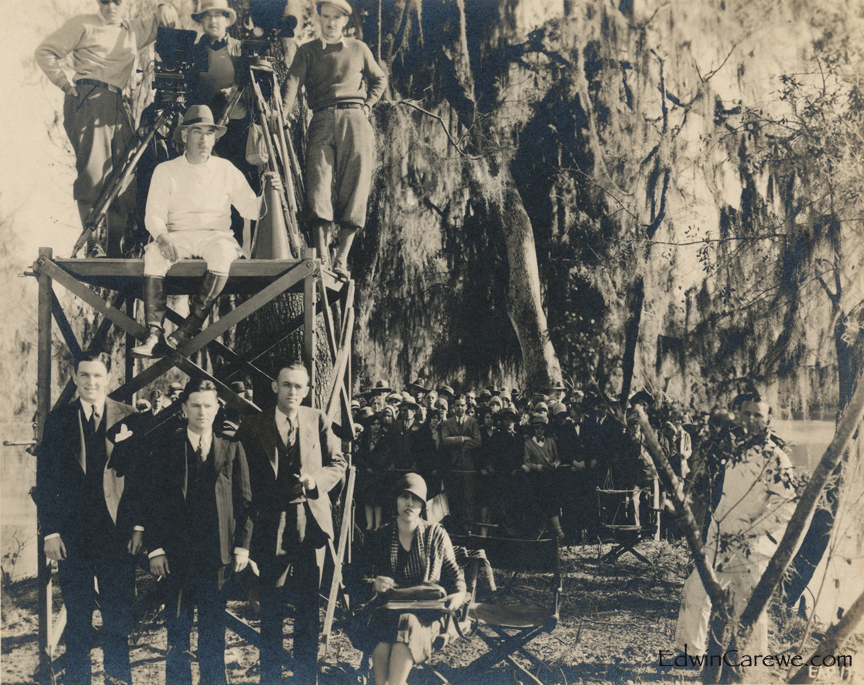Edwin Carewe was pioneering director during silent screen era
CONTRIBUTED BY Deborah Large, Media Relations.
This article appeared in the December 2014 edition of the Chickasaw Times
Fans of classic films will recognize the names of Gary Cooper, Mary Pickford and Ethyl Barrymore. These are among the most beloved stars of both the silent era, and “talkies” as sound movies were originally known.
But these noted actors, among many others, also have the distinction of working with a Chickasaw filmmaker who was among the most successful of his time. Edwin Carewe made his way in Hollywood as a director, writer and producer of some of the biggest hits of the silent era.
“He was a well-respected director in Hollywood,” Jan-Christopher Horak, director of the UCLA Film & Television Archive in Los Angeles, said. “He started directing films about 1914 but was even an actor before then. He was part of the system.”
Mr. Horak has worked closely in locating and preserving films made by and about Native Americans. His work in showcasing Mr. Carewe’s films has included screenings across the country and even in the preservation of one of the director’s most notable films.
“I think he was a very careful filmmaker,” Mr. Horak said. “His most well-known films, ‘Evangeline’ and ‘Ramona,’ are wonderful. In these, each scene is carefully composed, almost as if he was a painter. He had very high ambitions. I think he was really into film as art.”
Mr. Carewe was born Jay John Fox in 1883 in Gainesville, Texas, to Franklin Marion Fox and Sallie J. Priddy. Ms. Priddy was the daughter of Col. James P Priddy and Elizabeth McLish.
Mr. Carewe changed his name to Edwin Carewe when he went into film. His brothers, Franklin Finis Fox and Wallace Ware Fox, were also accomplished directors, producers and writers in Hollywood. Mr. Carewe is listed in the 1898 and 1907 Dawes Rolls as Chickasaw. There are references in Chickasaw archives of Finis Fox being elected to the Chickasaw legislature.
Mr. Carewe took his Chickasaw heritage with him when he began making fils in Hollywood – at least as much as the system would allow at the time.
“He was clearly drawn to Native American subject matter,” Mr. Horak said.
In 1925, Mr. Carewe signed actress Dolores del Rio to an exclusive contract. She appeared in his two most famous films. “Ramona,” Mr. Horak said, had an interesting history.
Many film historians thought the film had long since vanished or was destroyed over time. However, it was found in a film archive in the Czech Republic and restored to its original version. The restored version premiered to a UCLA audience in March of this year.
According to information provided by UCLA, the film is set in Southern California after the Mexican-American War. The film portrays the life of a mixed-race Native American orphan who suffers discrimination and hardship. Studio publicity of the time proclaimed, “MILLIONS – Have read the book. Will relive the romance! Will adore Dolores del Rio.”
The film, which didn’t shy away from the theme of cultural diversity and tolerance, was a major hit, reported UCLA.
“We showed the first screening of this film in probably 70 or 80 years since its original release,” Mr. Horak said. “I think it is a very interesting film based on a play. He directed and produced it. It had all the trappings of a real Hollywood film.”
Even in his film, and considering his Chickasaw heritage, he continued to be part of a Hollywood system, Mr. Horak said, that portrayed Native Americans in a somewhat unflattering way.
“In this film, you still get the Dolores del Rio character as a traditional Indian maiden,” he said. “But, to be a producer meant he was in control of the film. That made him unique in that regard. We don’t really get other Native Americans behind the camera for another 50 years.”
Even the theme song from “Ramona” was a big hit at the time. The song was recorded by Ms. del Rio in 1928.
Another of Mr. Carewe’s most well-known films is “Evangeline,” also starring Ms. del Rio. In this film, based on a poem by Henry Wadsworth Longfellow, the actress plays a woman caught in the middle of a war between France and England. She is forced out of Europe and moves to Louisiana where she begins to search for her long lost love from the war. She eventually arrives at a settlement of Jesuits and moves to Philadelphia to care for the maimed and friendless, where she is reunited with her long-sought beloved.
Like “Ramona,” most historians knew that only a small handful of films of this era survived. As it happened, Mr. Horak actually did the restoration of “Evangeline.”
“This is a beautiful film,” he said. “I believe the restored version is now housed at Eastman House.”
A clip of “Evangeline” can be viewed at www. Edwincarewe.com under the Filmography section.
“Edwin Carewe made important films with important actors,” Mr. Horak said. “Some would say his style was slow but I don’t think so. The coming of sound in films and a faster pace could be why his career ended.”
In 1934, Mr. Carewe attempted a comeback with a transition into the “talkies” with the film “Are We Civilized?” He died in 1940 of heart failure. This, his last motion picture, can be viewed in full on YouTube by searching “Are We Civilized?”
For more information on Carewe, including his Chickasaw heritage and film history, visit www.Edwincarewe.com.